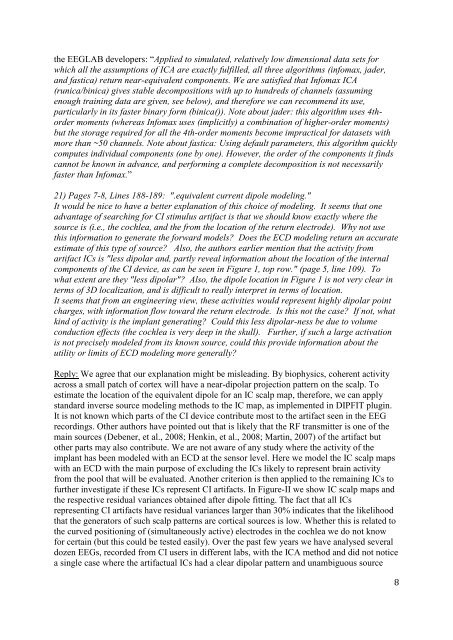Elsevier Editorial System(tm) for Hearing Research Manuscript Draft ...
Elsevier Editorial System(tm) for Hearing Research Manuscript Draft ...
Elsevier Editorial System(tm) for Hearing Research Manuscript Draft ...
You also want an ePaper? Increase the reach of your titles
YUMPU automatically turns print PDFs into web optimized ePapers that Google loves.
the EEGLAB developers: “Applied to simulated, relatively low dimensional data sets <strong>for</strong><br />
which all the assumptions of ICA are exactly fulfilled, all three algorithms (infomax, jader,<br />
and fastica) return near-equivalent components. We are satisfied that Infomax ICA<br />
(runica/binica) gives stable decompositions with up to hundreds of channels (assuming<br />
enough training data are given, see below), and there<strong>for</strong>e we can recommend its use,<br />
particularly in its faster binary <strong>for</strong>m (binica()). Note about jader: this algorithm uses 4thorder<br />
moments (whereas Infomax uses (implicitly) a combination of higher-order moments)<br />
but the storage required <strong>for</strong> all the 4th-order moments become impractical <strong>for</strong> datasets with<br />
more than ~50 channels. Note about fastica: Using default parameters, this algorithm quickly<br />
computes individual components (one by one). However, the order of the components it finds<br />
cannot be known in advance, and per<strong>for</strong>ming a complete decomposition is not necessarily<br />
faster than Infomax.”<br />
21) Pages 7-8, Lines 188-189: ".equivalent current dipole modeling."<br />
It would be nice to have a better explanation of this choice of modeling. It seems that one<br />
advantage of searching <strong>for</strong> CI stimulus artifact is that we should know exactly where the<br />
source is (i.e., the cochlea, and the from the location of the return electrode). Why not use<br />
this in<strong>for</strong>mation to generate the <strong>for</strong>ward models? Does the ECD modeling return an accurate<br />
estimate of this type of source? Also, the authors earlier mention that the activity from<br />
artifact ICs is "less dipolar and, partly reveal in<strong>for</strong>mation about the location of the internal<br />
components of the CI device, as can be seen in Figure 1, top row." (page 5, line 109). To<br />
what extent are they "less dipolar"? Also, the dipole location in Figure 1 is not very clear in<br />
terms of 3D localization, and is difficult to really interpret in terms of location.<br />
It seems that from an engineering view, these activities would represent highly dipolar point<br />
charges, with in<strong>for</strong>mation flow toward the return electrode. Is this not the case? If not, what<br />
kind of activity is the implant generating? Could this less dipolar-ness be due to volume<br />
conduction effects (the cochlea is very deep in the skull). Further, if such a large activation<br />
is not precisely modeled from its known source, could this provide in<strong>for</strong>mation about the<br />
utility or limits of ECD modeling more generally?<br />
Reply: We agree that our explanation might be misleading. By biophysics, coherent activity<br />
across a small patch of cortex will have a near-dipolar projection pattern on the scalp. To<br />
estimate the location of the equivalent dipole <strong>for</strong> an IC scalp map, there<strong>for</strong>e, we can apply<br />
standard inverse source modeling methods to the IC map, as implemented in DIPFIT plugin.<br />
It is not known which parts of the CI device contribute most to the artifact seen in the EEG<br />
recordings. Other authors have pointed out that is likely that the RF transmitter is one of the<br />
main sources (Debener, et al., 2008; Henkin, et al., 2008; Martin, 2007) of the artifact but<br />
other parts may also contribute. We are not aware of any study where the activity of the<br />
implant has been modeled with an ECD at the sensor level. Here we model the IC scalp maps<br />
with an ECD with the main purpose of excluding the ICs likely to represent brain activity<br />
from the pool that will be evaluated. Another criterion is then applied to the remaining ICs to<br />
further investigate if these ICs represent CI artifacts. In Figure-II we show IC scalp maps and<br />
the respective residual variances obtained after dipole fitting. The fact that all ICs<br />
representing CI artifacts have residual variances larger than 30% indicates that the likelihood<br />
that the generators of such scalp patterns are cortical sources is low. Whether this is related to<br />
the curved positioning of (simultaneously active) electrodes in the cochlea we do not know<br />
<strong>for</strong> certain (but this could be tested easily). Over the past few years we have analysed several<br />
dozen EEGs, recorded from CI users in different labs, with the ICA method and did not notice<br />
a single case where the artifactual ICs had a clear dipolar pattern and unambiguous source<br />
8
















